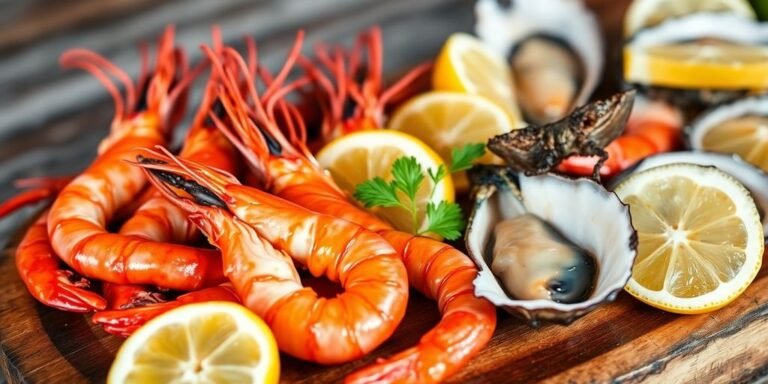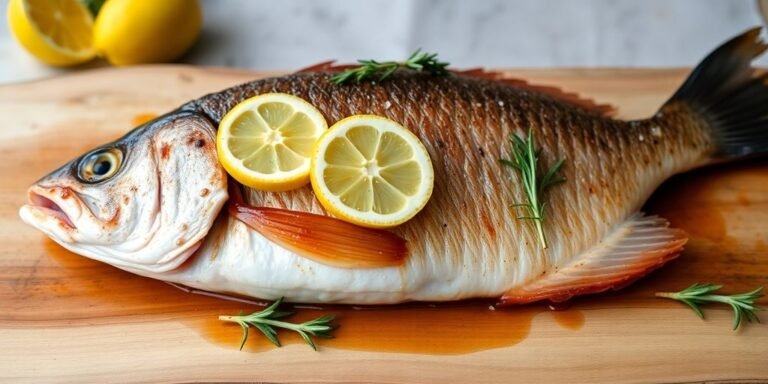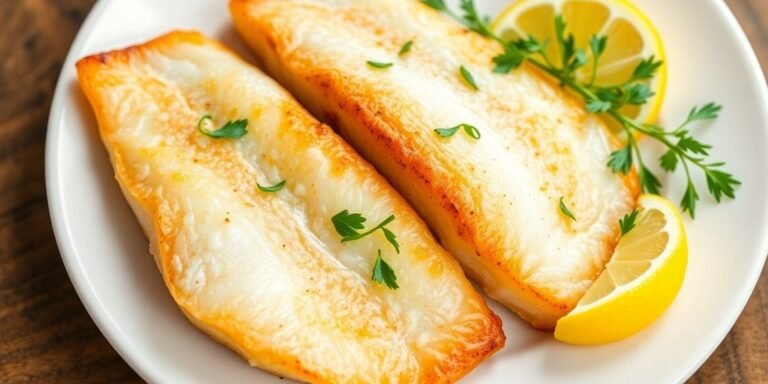Right then, let’s talk about how to cook basa fillets in oven. It’s a pretty straightforward thing to do, and honestly, it’s a good way to get some healthy protein on the table without much fuss. I’ve found that basa can be a bit bland on its own, but with a few simple tricks, you can make it really tasty. This guide will walk you through how to cook basa fillets in the oven, from picking the fish to serving it up. It’s not complicated, promise!
Key Takeaways
- Always pat your basa fillets dry before seasoning and cooking to avoid a mushy texture.
- Baking uncovered helps the fish get a nice flaky finish.
- Simple seasonings like lemon, herbs, paprika, salt, and butter or oil work wonders.
- A meat thermometer is your best mate for checking if the fish is cooked through (aim for 145°F or 63°C).
- Basa is a lean protein source that’s low in calories and good for you.
Preparing Your Basa Fillets For Baking
Getting your basa fillets ready for the oven is a straightforward process that sets the stage for a delicious meal. It doesn’t take much time at all, and a little bit of care here makes a big difference later on.
Choosing Your Basa Fillets
When you’re picking out basa fillets, look for ones that are a nice, opaque white colour. They should smell fresh, not fishy. If you’re buying them frozen, make sure there aren’t any ice crystals stuck to them, which can mean they’ve been thawed and refrozen. For the best results, try to get fillets that are roughly the same thickness so they cook evenly.
Thawing Frozen Basa
If your basa is frozen, it’s best to thaw it properly before you cook it. The safest way is to move the fillets from the freezer to the fridge the night before you plan to cook. If you’re in a hurry, you can put the frozen fillets in a sealed plastic bag and submerge that in a bowl of cold water. Change the water every 10-15 minutes until the fish is thawed. Never thaw fish at room temperature. Once thawed, it’s important to pat the fillets completely dry with paper towels.
Essential Seasonings and Marinades
Basa has a mild flavour, so it really benefits from a bit of seasoning. Simple is often best. A good starting point is a mix of olive oil or melted butter, salt, pepper, and maybe some garlic powder or onion powder. For a bit more zing, lemon juice or a splash of white wine works wonders. You can also create a quick marinade by combining olive oil, lemon juice, minced garlic, and your favourite herbs like dill, parsley, or thyme. Let the fish sit in the marinade for about 20-30 minutes before baking.
Oven Baking Basa Fillets: The Method
Getting your basa fillets into the oven is pretty straightforward, but a few little things can make a big difference to the final result. It’s not complicated, but paying attention to these details means you’ll end up with a much nicer piece of fish.
Preheating Your Oven
This is one of those steps that’s easy to skip when you’re in a hurry, but it’s really important. You want your oven to be at the right temperature before the fish goes in. This helps the fish cook evenly and prevents it from getting soggy. Most recipes suggest around 180°C to 200°C (350°F to 400°F), depending on how quickly you want it done and what other flavours you’re using. A properly preheated oven means the fish starts cooking straight away, giving you that lovely flaky texture.
Baking Temperature and Time
So, what temperature and how long? Generally, for basa fillets, you’re looking at about 180°C (350°F) for around 20-30 minutes. Thicker fillets might need a bit longer, maybe up to 30 minutes, while thinner ones could be done in 15-20. It really depends on the thickness of your fillets. A good rule of thumb is to check the thickest part. If it flakes easily with a fork, it’s usually ready. You don’t want to overcook it, or it’ll get dry.
Baking Uncovered for Flakiness
When you’re baking basa, it’s generally best to leave the fillets uncovered. This allows the moisture to escape, which helps the fish develop a nicer, flaky texture. If you cover the fish, it tends to steam rather than bake, and you won’t get that desirable flakiness. Think of it like getting a nice crust on bread – you need the heat to circulate properly. This method is great for simple preparations, like a lemon and herb baked basa, which you can find more about on this recipe page.
Leaving your fish uncovered in the oven helps the outside dry out slightly, which is key to achieving that lovely flaky texture we’re after. It’s a simple step that really pays off.
Flavour Enhancements for Baked Basa
Basa fillets are pretty mild on their own, which is actually a good thing because it means they soak up flavours really well. You don’t need much to make them taste great.
Lemon and Herb Combinations
This is a classic for a reason. A simple mix of lemon juice, some fresh or dried herbs like dill, parsley, or thyme, and a bit of garlic can make a big difference. Just a tablespoon of olive oil or melted butter mixed with these ingredients and brushed over the fish before baking works wonders. It keeps the fish moist and adds a lovely brightness. You can find some great ideas for these kinds of flavour pairings in various easy baked fish recipes.
Spices for a Paprika Kick
If you like a bit more warmth, sweet paprika is a fantastic addition. It gives the fish a nice colour and a subtle, smoky flavour. Combine it with a pinch of salt, maybe some onion powder or garlic powder, and you’ve got a simple yet effective seasoning. Some people even add a touch of chilli powder if they enjoy a bit of heat. A sprinkle of dried basil alongside the paprika is also a popular choice.
Butter and Oil Bases
Butter adds a richness that complements the mildness of basa. Melted butter, perhaps with a splash of lemon juice and your chosen herbs or spices, creates a simple marinade. Olive oil is another great option, offering a lighter flavour profile. You can even mix butter and olive oil for a balance of richness and a cleaner taste. Using a good quality fat base helps carry the flavours into the fish.
Remember that basa is quite forgiving, so don’t be afraid to experiment with different spice blends and herb combinations to find what you like best.
Achieving Perfect Basa Texture
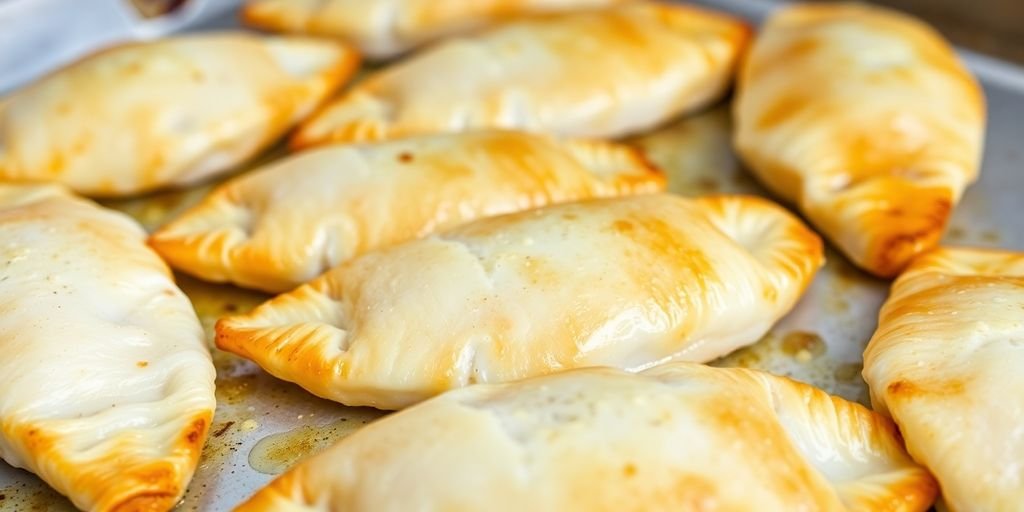
Getting the texture right for your baked basa fillets is pretty straightforward, but there are a few things to keep in mind. You want that lovely flaky result, not something that’s mushy or dry. It’s all about handling the fish properly before and during the cooking process.
Avoiding Mushy Fish
Mushy fish is usually a sign of one of two things: either the fish was overcooked, or it had too much moisture to begin with. Basa is a delicate fish, so it doesn’t need a long time in the oven. Overcooking it will break down the proteins too much, leading to that unpleasant texture. Also, if you don’t get rid of excess water, it can steam rather than bake properly, which also contributes to a softer, mushier outcome.
The Importance of Patting Dry
This step is really quite important. Before you season or marinate your basa fillets, take a few paper towels and gently pat them dry on all sides. This removes any surface moisture that might be left from thawing or packaging. Removing this excess water helps the fish to brown slightly and develop a better texture when baked. It allows the seasonings to adhere better too, giving you more flavour. It’s a simple step, but it makes a noticeable difference.
Using a Meat Thermometer
While you can often tell if fish is cooked by how easily it flakes with a fork, using a meat thermometer is the most reliable way to guarantee perfect results every time. For basa, you’re looking for an internal temperature of around 63°C (145°F). Insert the thermometer into the thickest part of the fillet. This takes the guesswork out of cooking and helps you avoid both undercooked and overcooked fish. It’s a handy tool for all sorts of cooking, not just fish, and can really help you nail that ideal texture. You can find a good quality meat thermometer at most kitchenware stores or online retailers.
Serving Your Oven-Baked Basa
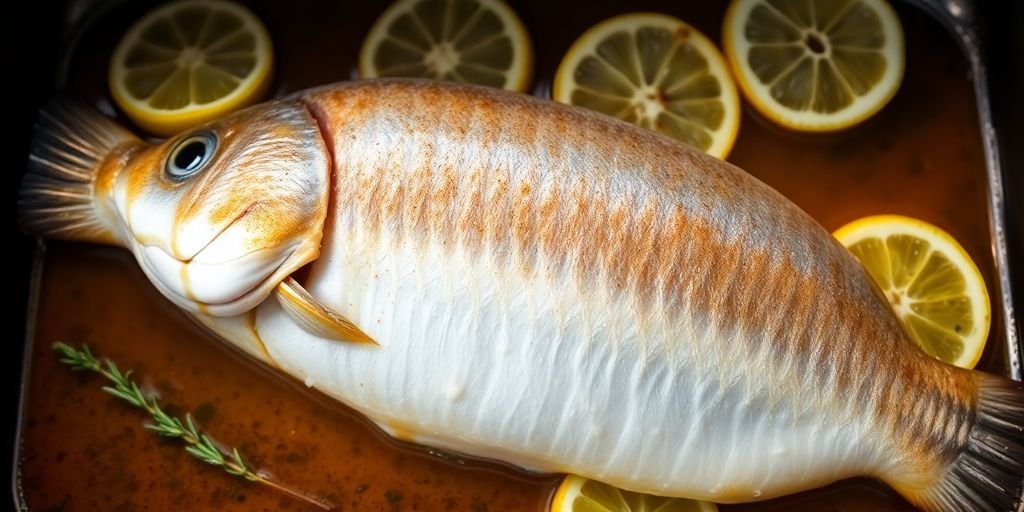
Now that you’ve got your perfectly baked basa fillets, it’s time to think about how to present them. Serving your fish well can really make a difference to the whole meal experience.
Simple Serving Suggestions
Baked basa is quite versatile, so you can go with something really straightforward. A squeeze of fresh lemon or lime over the top just before serving really brightens the flavour. If you’ve baked it with herbs, letting those shine is usually best. Don’t overcomplicate it; the fish itself is the star.
Pairing with Grains and Greens
For a balanced meal, consider what you’re serving alongside your basa. Fluffy couscous or quinoa are great options that soak up any juices nicely. Steamed greens like broccoli or asparagus add a fresh, healthy element. A simple side salad with a light vinaigrette also works wonderfully. You might even find some quick and delicious fish dinner ideas that pair perfectly.
Garnishing for Presentation
Presentation matters, even for a simple dish. A few fresh herb sprigs, like parsley or dill, can add a pop of colour. A thin slice of lemon or lime on the side of the plate looks professional. If you’ve used paprika, a tiny sprinkle of extra paprika can look nice too. A little effort in garnishing goes a long way.
Nutritional Benefits of Basa
Protein and Low-Calorie Profile
Basa fillets are a fantastic source of lean protein, which is vital for muscle repair and growth. What’s really good about it is that it’s also quite low in calories. This makes it a smart choice if you’re watching your weight or just looking for a lighter meal option. It’s a win-win for feeling full and keeping your calorie intake in check.
Omega-3 Fatty Acids
While not as famously high as some oily fish, basa does contain Omega-3 fatty acids. These are the good fats that are known for their heart-health benefits and can help reduce inflammation in the body. Including fish like basa in your diet regularly can contribute to your overall well-being.
Essential Minerals
Beyond protein and healthy fats, basa also provides certain essential minerals. It contains potassium, which is important for maintaining healthy blood pressure, and zinc, which plays a role in immune function. These minerals, though present in smaller amounts, add to the overall nutritional value of the fish. You can find out more about healthy eating choices at Australian dietary guidelines.
Here’s a quick look at the typical nutritional breakdown per 100g serving (this can vary slightly depending on preparation):
| Nutrient | Amount (approx.) |
|---|---|
| Calories | 101 kcal |
| Protein | 2g |
| Fat | 8g |
| Carbohydrates | 7g |
| Sodium | 127mg |
| Potassium | 231mg |
Wrapping Up Your Basa Bake
So there you have it, a super simple way to get some tasty basa fillets on the table. It’s a pretty forgiving recipe, which is great if you’re just starting out or just need a quick meal. You can tweak the spices a bit if you like, but the basic idea is sound. It’s a good option for a healthy weeknight dinner without much fuss. Give it a go next time you’re looking for something easy and good for you.
Frequently Asked Questions
How long does it take to cook basa fillets in the oven?
Basa fillets usually cook in about 12 to 15 minutes when baked at 200°C (400°F). Keep an eye on them, as thicker fillets might take a little longer. It’s best to check if the fish flakes easily with a fork.
Can I use frozen basa fillets for this recipe?
You sure can! Just make sure to thaw them completely first. Give them a good pat dry with paper towels before you season and bake them. This helps get a nicer texture.
Should I bake basa fillets covered or uncovered?
Yep, baking uncovered is the way to go for basa! It helps the fish get a lovely, flaky texture. Covering it can make it a bit too moist and mushy.
My basa fillets always turn out mushy, what am I doing wrong?
To avoid mushy fish, make sure you pat the fillets really dry with paper towels before you add any seasonings or marinades. Also, don’t overcook it! Using a meat thermometer to check if it reaches an internal temperature of around 63°C (145°F) is a good trick.
Is basa fish healthy to eat?
Absolutely! Basa is a fantastic choice because it’s packed with protein and is quite low in calories, making it a healthy option. It also contains good fats like Omega-3s, which are great for your heart and brain.
What should I serve with my oven-baked basa?
You can serve your baked basa with all sorts of things! It goes really well with simple sides like fluffy rice, quinoa, or some roasted veggies. A fresh salad or some steamed greens like broccoli or asparagus are also excellent choices.
